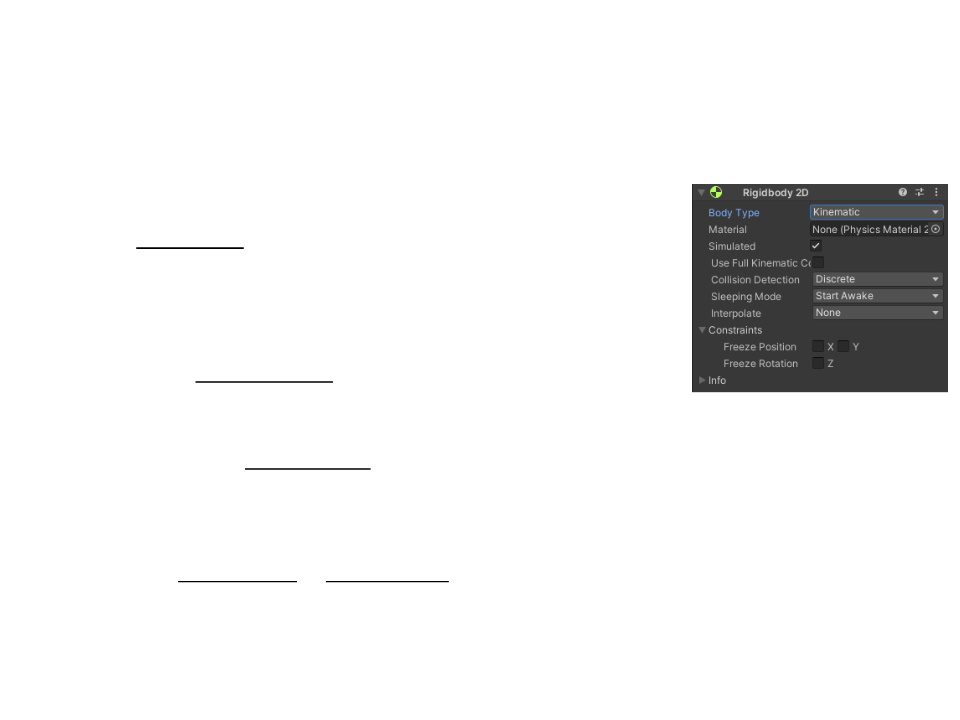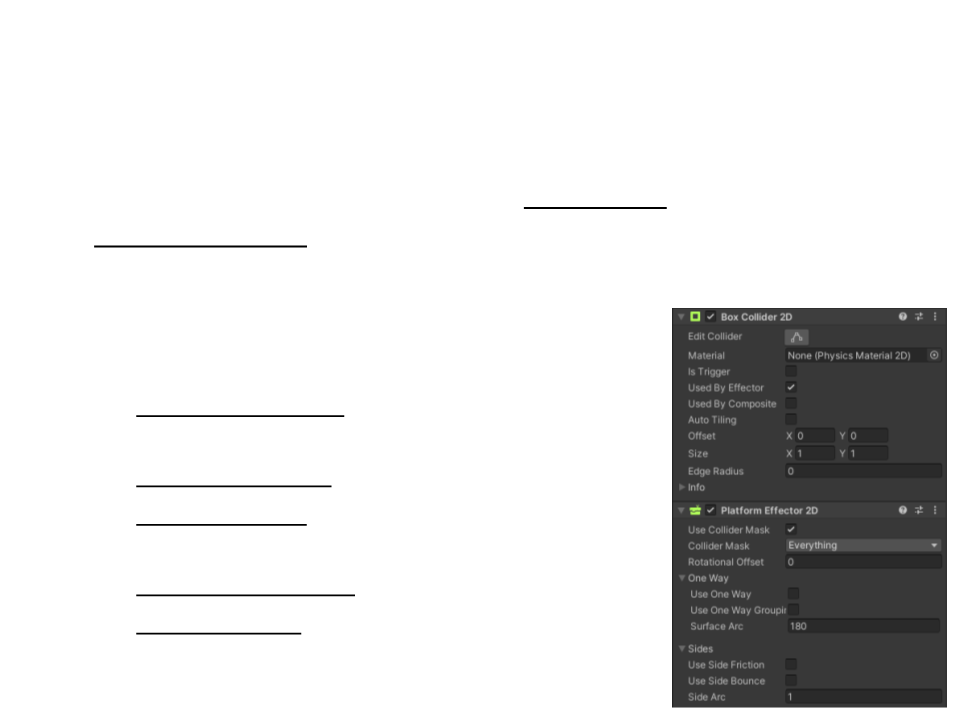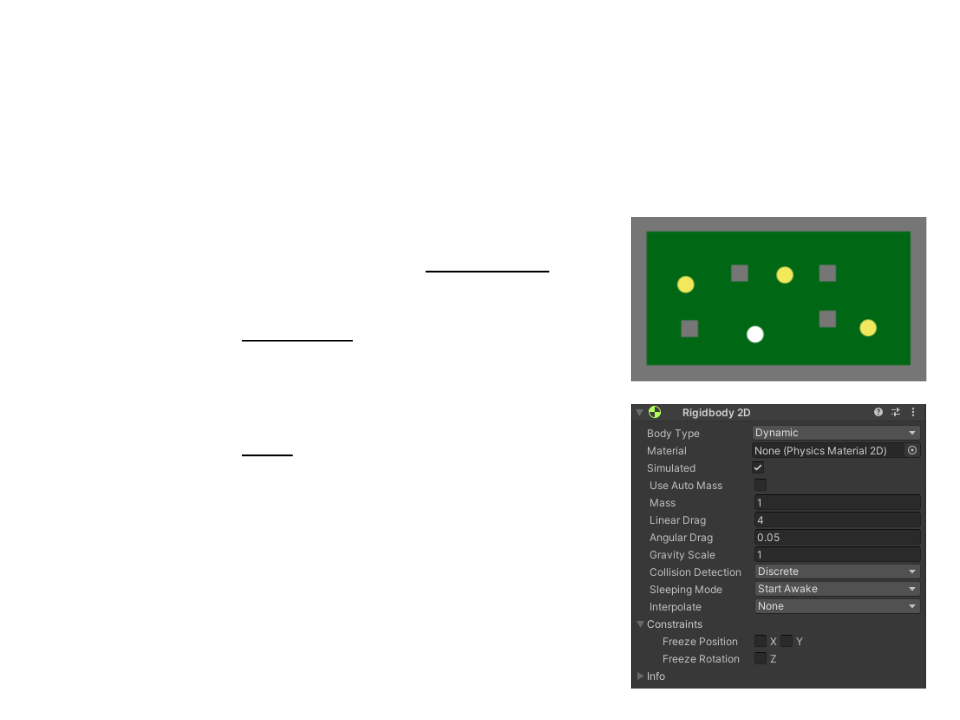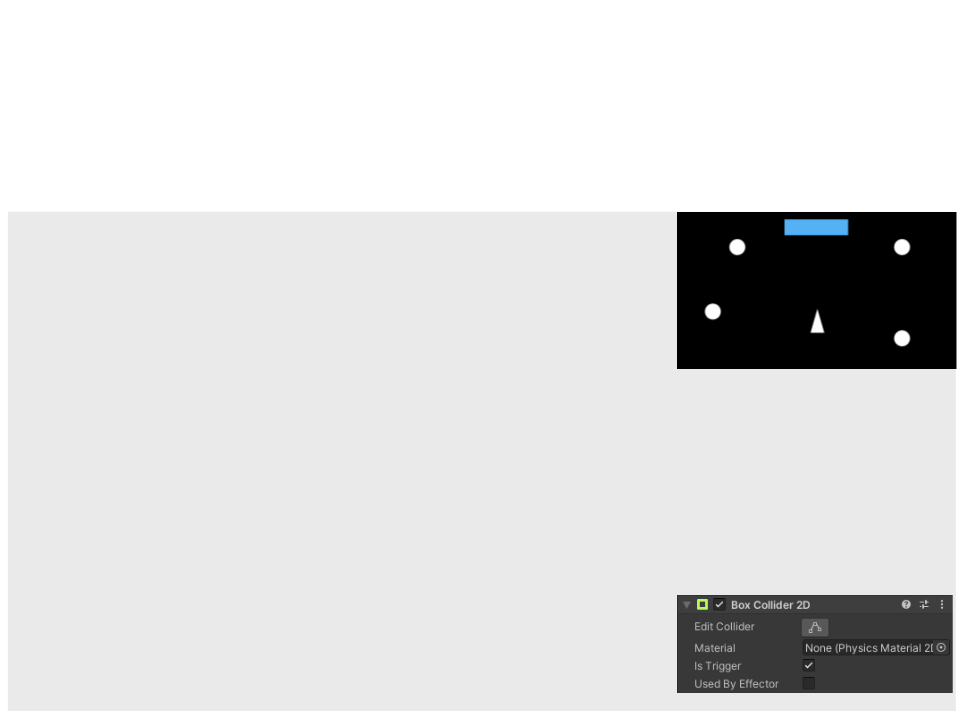
Game Frameworks
Lecture 03: 2D Physics in Unity
Edirlei Soares de Lima
<edirlei.lima@universidadeeuropeia.pt>

Unity – Physics
•
•
Unity simulates physics in 2D and 3D to ensure that objects
correctly accelerate and respond to collisions, gravity, and
various other forces.
–
3D physics: Nvidia PhysX engine integration
–
2D physics: Box2D engine integration
Main components:
–
Rigidbodies
–
Colliders

Rigidbody 2D
•
Rigidbody is the main component that
enables physical behavior for a GameObject.
–
With a Rigidbody attached, the object will
immediately respond to gravity.
–
If a Collider component is also added, the
GameObject will be moved by incoming collisions.
•
Important: since a Rigidbody component controls the
movement of the GameObject, never try to move it
from a script by changing the Transform properties
such as position and rotation.
–
Instead, use the physics engine to apply forces to push the
GameObject and let the physics engine calculate the results.

Rigidbody 2D
•
Body Type:
–
Dynamic: for objects designed to move under
simulation. It uses the full set of properties, such
as finite mass and drag, and is affected by gravity
and forces.
•
•
•
A Dynamic body will collide with every other body type.
It is the most performance-expensive body type.
Never use a script to set the position or rotation of a
Dynamic Rigidbody using its Transform component.

Rigidbody 2D
•
Body Type:
–
Kinematic: for objects designed to move under
simulation, but only under very explicit user
control. It is not affected by gravity and forces.
•
•
•
It does not collide with other Kinematic or Static
Rigidbodies (only collides with Dynamic Rigidbodies).
It has a lower demand on system resources than a
Dynamic Rigidbody.
It is designed to be repositioned explicitly via
MovePosition or MoveRotation functions.

Rigidbody 2D
•
Body Type:
–
Static: for objects designed to not move under
simulation at all. If anything collides with it, the
object behaves like an immovable object.
•
•
•
Only collides with Dynamic Rigidbodies.
The least resource-intensive body type.
All GameObjects that have a Collider component and do
not have a Rigidbody, are automatically considered Static
RigidBodies.

Collider 2D
•
A Collider component defines the shape of a
GameObject for the purposes of physical
collisions.
–
A collider is invisible and does not need to be the
exact same shape as the object.
•
Rough approximations are often more efficient and
indistinguishable in gameplay).
–
–
The simplest (and least processor-intensive)
colliders are primitive collider types:
•
Box, Circle, and Capsule.
More complex and customizable colliders:
•
Edge and Polygon.

Physics – Example 1
•
Example 1: Hello Physics World
–
–
–
Add Box Colliders 2D to the platforms.
Add a Circle Collider 2D to the ball.
Add a RigidBody 2D to the Ball.

Physics Material 2D
•
A Physics Material is used to adjust the
friction and bounce that occurs between
physics objects when they collide.
–
Example: Ball bouncing

Scripting – Add Force
•
Example 2: Moving the Ball with a Force
public class BallMovement : MonoBehaviour
{
public float moveForce = 20;
private Rigidbody2D rigidBody;
private void Start()
{
rigidBody = GetComponent<Rigidbody2D>();
}
private void FixedUpdate()
{
float horizontalInput = Input.GetAxis("Horizontal");
rigidBody.AddForce(Vector2.right * horizontalInput *
moveForce);
}
}
–
Important: always use FixedUpdate when manipulating a Rigidbody.

Scripting – Vector2 Class
•
•
The Vector2 class represents 2D vectors.
–
It also contains functions and properties for common vector
operations: magnitude, normalization, dot product, cross product,
angle, etc.
Main Constants:
–
–
–
–
–
–
Vector2.down: shorthand for writing Vector2(0, -1).
Vector2.left: shorthand for writing Vector2(-1, 0).
Vector2.one: shorthand for writing Vector2(1, 1).
Vector2.right: shorthand for writing Vector2(1, 0).
Vector2.up: shorthand for writing Vector2(0, 1).
Vector2.zero: shorthand for writing Vector2(0, 0).

Scripting – Vector2 Class
•
Main functions:
Vector2.Angle(Vector2 from, Vector2 to): returns the unsigned angle in degrees
between from and to.
–
–
Vector2.ClampMagnitude(Vector2 vector, float maxLength): returns a copy of
vector with its magnitude clamped to maxLength.
–
–
–
Vector2.Distance(Vector2 a, Vector2 b): returns the distance between a and b.
Vector2.Dot(Vector2 lhs, Vector2 rhs): dot Product of two vectors.
Vector2.Lerp(Vector2 a, Vector2 b, float t): linearly interpolates between
vectors a and b by t.
–
–
Vector2.MoveTowards(Vector2 current, Vector2 target, float maxDistanceDelta):
moves a point current towards target.
Vector2.SmoothDamp(Vector2 current, Vector2 target, ref Vector2
currentVelocity, float smoothTime, float maxSpeed = Mathf.Infinity, float
deltaTime = Time.deltaTime): Gradually changes a vector towards a desired goal
over time.

Scripting – Velocity Change
•
Example 3: Player Movement (Platform Game)
public class PlayerMovement : MonoBehaviour
{
public float moveForce = 6;
private Rigidbody2D rigidBody;
private void Start()
{
rigidBody = GetComponent<Rigidbody2D>();
}
private void FixedUpdate()
{
float horizontalInput = Input.GetAxis("Horizontal");
rigidBody.velocity = new Vector2(horizontalInput *
moveForce, rigidBody.velocity.y);
}
}

Effectors 2D
•
•
Effector 2D are components that control the
forces of physics when GameObject colliders
come into contact with each other.
Effectors:
–
PlatformEffector2D: creates platform behaviors
such as one-way collisions and no side friction;
–
–
SurfaceEffector2D: simulates conveyor belts;
PointEffector2D: attracts or repulses against a
given source point;
–
–
BuoyancyEffector2D: makes GameOjects float;
AreaEffector2D: randomly vary force and angle
magnitude;

Scripting – Impulse Force & Raycast
•
Example 4: Player Jump (Platform Game)
public class PlayerMovement : MonoBehaviour{
public float moveForce = 6;
public float jumpForce = 7.2f;
private Rigidbody2D rigidBody;
private float feetOffset = 0;
private void Start(){
rigidBody = GetComponent<Rigidbody2D>();
BoxCollider2D collider = GetComponent<BoxCollider2D>();
feetOffset = ((collider.size.y * transform.localScale.y) / 2)+ 0.01f;
}
private bool IsOnGround(){
Vector2 playerFeet = new Vector2(transform.position.x,
transform.position.y - feetOffset);
RaycastHit2D hit = Physics2D.Raycast(playerFeet, Vector2.down, 2.0f);
if (hit.collider != null){
float distance = Mathf.Abs(hit.point.y - playerFeet.y);
if (distance < 0.1){
return true;
}
}
return false;
}

Scripting – Impulse Force & Raycast
•
Example 4: Player Jump (Platform Game)
...
private void FixedUpdate()
{
float horizontalInput = Input.GetAxis("Horizontal");
float jumpInput = Input.GetAxis("Jump");
if ((jumpInput > 0) && (IsOnGround()))
{
rigidBody.AddForce(Vector2.up * jumpForce, ForceMode2D.Impulse);
}
rigidBody.velocity = new Vector2(horizontalInput * moveForce,
rigidBody.velocity.y);
}
}

Physics 2D – Raycast
•
The Raycast function casts a ray against colliders in the Scene.
RaycastHit2D Raycast(Vector2 origin, Vector2 direction, float distance =
Mathf.Infinity, int layerMask = DefaultRaycastLayers,
float minDepth = -Mathf.Infinity, float maxDepth =
Mathf.Infinity);
–
Returns a RaycastHit object with a reference to the collider that is hit
by the ray.
•
The collider property of the result will be NULL if nothing was hit.
–
The layerMask can be used to detect objects selectively only on
certain layers.
•
In last example, the function IsOnGround() can be optimized by defining a Layer on
objects that represent ground. The Layer can then be used in the layer mask
parameter to only check collisions with relevant objects.
RaycastHit2D hit = Physics2D.Raycast(playerFeet, Vector2.down, 2.0f,
LayerMask.GetMask("Ground"));

Physics 2D Settings
•
Edit -> Project Settings
–
Physics 2D settings can be used
to change global settings for 2D
physics simulation.

Scripting – Top-Down Movement
•
Example 5: Player Movement (Top-Down Game)
public class TopDownPlayerMovement : MonoBehaviour
{
public float moveForce = 6;
private Rigidbody2D rigidBody;
private void Start()
{
rigidBody = GetComponent<Rigidbody2D>();
}
private void FixedUpdate()
{
float horizontalInput = Input.GetAxis("Horizontal");
float verticalInput = Input.GetAxis("Vertical");
rigidBody.velocity = new Vector2(horizontalInput * moveForce,
verticalInput * moveForce);
}
}

Scripting – Top-Down Movement
•
Example 6: Pushing Objects (Top-Down Game)
–
–
Dynamic objects must have a RigidBody2D.
Adjust the Linear Drag to make them stop faster.
•
For the physics engine, the objects are in the air, so there
is not friction.
–
Adjust the Mass to make objects heavier.

Scripting – Top-Down Movement
•
Example 7: Player Movement based on Mouse Position
public class SpaceshipMovement : MonoBehaviour{
public float moveForce = 3;
public float minMouseDistance = 50;
private Rigidbody2D rigidBody;
private void Start(){
rigidBody = GetComponent<Rigidbody2D>();
}
private void FixedUpdate(){
float horizontalInput = Input.GetAxis("Horizontal");
float verticalInput = Input.GetAxis("Vertical");
Vector2 mouseDirection = Input.mousePosition -
Camera.main.WorldToScreenPoint(transform.position);
if (mouseDirection.magnitude > minMouseDistance){
float rotationAngle = Mathf.Atan2(mouseDirection.normalized.y,
mouseDirection.normalized.x) * Mathf.Rad2Deg;
rigidBody.SetRotation(rotationAngle - 90);
}
rigidBody.velocity = (((transform.up * verticalInput) +
(transform.right * horizontalInput)) * moveForce);
}
}

Scripting – 2D Physics Events
•
•
Collision Events:
–
–
–
void OnCollisionEnter2D(Collision collision) – is called when the
collider/rigidbody has begun touching another rigidbody/collider.
void OnCollisionStay2D(Collision collision) – is called once per frame for every
collider/rigidbody that is touching the rigidbody/collider.
void OnCollisionExit2D(Collision collision) – is called when the collider/rigidbody
has stopped touching another rigidbody/collider.
Trigger Events:
–
–
–
void OnTriggerEnter2D(Collider collider) – is called when the collider/rigidbody
has begun touching another collider that is a trigger.
void OnTriggerStay2D(Collider collider) – is called once per frame for every
trigger collider that is touching the rigidbody/collider.
void OnTriggerExit2D(Collider collider) – is called when the collider/rigidbody
has stopped touching another collider that is a trigger.

Scripting – 2D Physics Events
•
Example 8: Destroy the Spaceship on Collision
public class SpaceshipMovement : MonoBehaviour{
...
private void OnCollisionEnter2D(Collision2D collision)
{
if (collision.collider.tag == "Asteroid")
{
Destroy(gameObject);
}
}
}

Scripting – 2D Physics Events
•
Example 9: Change the color of the Spaceship when it enters the heal area.
public class HealArea : MonoBehaviour
{
private void OnTriggerEnter2D(Collider2D collision)
{
if (collision.gameObject.tag == "Player")
{
collision.gameObject.GetComponent<SpriteRenderer>().color = Color.blue;
}
}
private void OnTriggerExit2D(Collider2D collision)
{
if (collision.gameObject.tag == "Player")
{
collision.gameObject.GetComponent<SpriteRenderer>().color = Color.white;
}
}
}

Scripting – 2D Physics Events
•
Example 10: Shooting and Destroying Asteroids
public class TopDownPlayerMovement : MonoBehaviour
{
public float moveForce = 3;
public float minMouseDistance = 50;
public GameObject bulletPrefab;
public float bulletForce = 12;
public float bulletStartOffset = 1.2f;
public float cooldownTime = 0.5f;
private Rigidbody2D rigidBody;
private float shootTimer = 0;
private void Start(){
rigidBody = GetComponent<Rigidbody2D>();
}
private void OnCollisionEnter2D(Collision2D collision){
if (collision.collider.tag == "Asteroid"){
Destroy(gameObject);
}
}
...

Scripting – 2D Physics Events
•
Example 10: Shooting and Destroying Asteroids
...
private void Update()
{
float fireInput = Input.GetAxis("Fire1");
if ((fireInput > 0) && (shootTimer <= 0))
{
Vector3 mouseDirection = Input.mousePosition –
Camera.main.WorldToScreenPoint(transform.position);
GameObject bullet = Instantiate(bulletPrefab, transform.position +
(mouseDirection.normalized * bulletStartOffset),
Quaternion.identity);
bullet.GetComponent<Rigidbody2D>().velocity = mouseDirection.normalized
bulletForce;
*
shootTimer = cooldownTime;
}
if (shootTimer >= 0)
{
shootTimer -= Time.deltaTime;
}
}
...

Scripting – 2D Physics Events
•
Example 10: Shooting and Destroying Asteroids
private void FixedUpdate()
{
float horizontalInput = Input.GetAxis("Horizontal");
float verticalInput = Input.GetAxis("Vertical");
Vector2 mouseDirection = Input.mousePosition –
Camera.main.WorldToScreenPoint(transform.position);
if (mouseDirection.magnitude > minMouseDistance)
{
float rotationAngle = Mathf.Atan2(mouseDirection.normalized.y,
mouseDirection.normalized.x) * Mathf.Rad2Deg;
rigidBody.SetRotation(rotationAngle - 90);
}
rigidBody.velocity = (((transform.up * verticalInput) + (transform.right *
horizontalInput)) * moveForce);
}
}

Exercise 1
1
) Create an enemy for a 2D platform game that can only be
killed by jumping on his head (like some enemies of Super
Mario games).
–
Start with the code created for the player jump example.
–
If the player touches the sides of the enemy, the player dies.
Enemy
Enemy
Kill the enemy
Player dies

2
D Joints
•
•
Joints can be used to attach GameObjects together.
There are different types of 2D joints:
–
–
Distance Joint 2D - attaches two GameObjects and keeps them a certain distance apart.
Fixed Joint 2D - keeps two objects in a position relative to each other, so the objects are
always offset at a given position and angle.
–
–
–
Friction Joint 2D - reduces both the linear and angular velocities between two
GameObjects to zero
Hinge Joint 2D - allows a GameObject to be attached to a point in space around which it
can rotate.
Relative Joint 2D - allows two GameObjects to maintain a position based on each other’s
location.
–
–
–
–
Slider Joint 2D - allows a GameObject to slide along a line in space.
Spring Joint 2D - allows two GameObjects to be attached together by a spring.
Target Joint 2D - connects to a specified target, rather than another rigid body.
Wheel Joint 2D - simulates wheels and suspension.

Distance Joint 2D
•
Distance Joint 2D – Attaches two GameObjects and keeps
them a certain distance apart.
–
Update the Line Renderer positions do show a line:
private void Update()
{
Rigidbody2D attachedBall = GetComponent<DistanceJoint2D>().connectedBody;
LineRenderer line = GetComponent<LineRenderer>();
line.SetPosition(0, transform.position);
line.SetPosition(1, attachedBall.transform.position);
}

Hinge Joint 2D
•
Hinge Joint 2D - allows a GameObject to be attached to a
point in space around which it can rotate.
–
Update the Line Renderer positions do show a line:
private void Update()
{
HingeJoint2D hinge = GetComponent<HingeJoint2D>();
LineRenderer line = GetComponent<LineRenderer>();
line.SetPosition(0, transform.position);
line.SetPosition(1, hinge.connectedBody.position);
}

Spring Joint 2D
•
Spring Joint 2D - allows two GameObjects to be attached
together by a spring.
–
Update the Line Renderer positions do show a line:
private void Update(){
SpringJoint2D hinge = GetComponent<SpringJoint2D>();
if (hinge){
LineRenderer line = GetComponent<LineRenderer>();
line.SetPosition(0, transform.position);
line.SetPosition(1, hinge.connectedBody.position);
}
else{
Destroy(GetComponent<LineRenderer>());
}
}

Further Reading
•
Unity User Manual, Available at: https://docs.unity3d.com/2020.1/
Documentation/Manual/
–
2D
•
•
•
•
•
•
Gameplay in 2D
Physics Reference 2D
Rigidbody 2D
Collider 2D
Effectors 2D
2D Joints
•
Books
–
Jeremy G. (2017). Introduction to Game Design, Prototyping, and
Development: from the Concept to Playable Game - with Unity and C# (2nd
ed.). Boston, MA: Addison-Wesley Professional. ISBN: 978-0134659862
–
Hocking, J. (2018). Unity in Action: Multiplatform Game Development in C#
(2nd ed.). Shelter Island, NY: Manning Publications. ISBN: 978-1617294969
